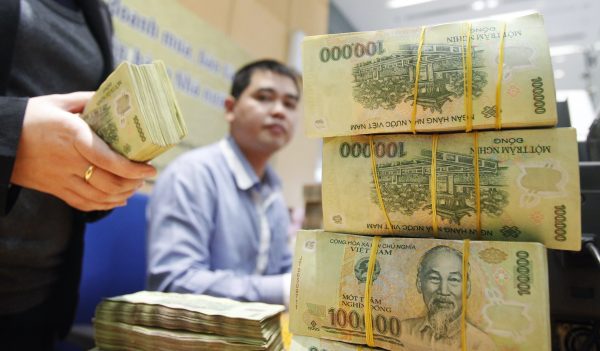It is now up to the Biden administration to decide what, if any, action to take.
Many have argued that Vietnam benefited from the so-called trade war between the United States and China, particularly since the imposition of Section 301 tariffs against Chinese imports starting in 2018.
One indicator often cited is the rapidly growing US trade deficit with Vietnam. In 2020, Vietnam had the third largest trade surplus in goods against the United States at US$69.7 billion (a 24.9 per cent year-on-year growth from 2019) — overtaking Japan and Germany. From 2018–2020, the Chinese trade surplus with the United States declined by more than US$108.2 billion (a drop of 25.8 per cent), while the trade surplus of Vietnam increased by more than US$30.2 billion (an increase of 76.4 per cent). Given the Trump administration’s aim to curb the overall US trade deficit, observers have long warned that Vietnam’s currency valuation could end up the focus of action as a proxy to target Vietnam’s trade surplus.
While there were intense talks during the Trump administration — including a call between Trump and Vietnamese Prime Minister Nguyen Xuan Phuc — there are no reports suggesting any ongoing talks with the Biden administration.
When the Trump administration withdrew from the Trans-Pacific Partnership (TPP), it also abandoned currency provisions that would have allowed the two countries to address currency valuation issues multilaterally with enhanced transparency and accountability. But the TPP did not include an enforcement mechanism, which led industry groups such as the United Auto Workers union to oppose it. Given these concerns, the United States–Mexico–Canada Agreement (USMCA), negotiated under the Trump administration, does contain an enforceable mechanism.
US President Joe Biden and USTR Katherine Tai have been reluctant to endorse the TPP. If Biden believes that repairing relations and embracing multilateralism is part of his ‘return to normalcy’, one way to address the currency issue is returning to the negotiating table for the TPP. He could revisit provisions suspended under the Comprehensive and Progressive Agreement for Trans-Pacific Partnership (CPTPP) and avoid a more unilateral approach such as using Section 301.
The Section 301 Report provides three key findings in which Vietnam’s practices under investigation are actionable. It does not provide clear criteria for finding currency manipulation and instead heavily relies on Treasury Department conclusions.
First, Vietnam’s currency undervaluation lowers the cost of Vietnamese imports into the United States, which undermines the competitiveness of domestic US firms. Second, it raises the local currency price of US exports to Vietnam, which makes US firms less competitive in Vietnam. Third, Vietnam’s alleged foreign exchange market intervention has coincided with its current account surplus, undermining US export opportunities. Yet some argue that there is insufficient evidence that Vietnam’s central bank is actively devaluing its currency.
Using Section 301 as a way to address Vietnam’s currency valuation is seen controversial since it circumvents procedures laid out by Congress in the Omnibus Trade and Competitiveness Act of 1988 and the Trade Facilitation and Trade Enforcement Act of 2015 (TFTEA).
Concerns regarding Vietnam’s currency were formally raised in May 2019 when the Treasury put Vietnam on its monitoring list. In December 2020, the Treasury released its currency manipulation report, accusing both Vietnam and Switzerland of being manipulators.
Debates around what Treasury could do once it declares a country a currency manipulator are rather murky. When China was designated a currency manipulator in 2019, Alan Beattie opined that ‘there are no practical consequences except having the US start negotiations either bilaterally or at the IMF’. The Congressional Research Service notes that the ‘1988 Trade Act does not prescribe putative measures if initial negotiations fail to result in policy changes, as required by the [TFTEA]’. Actions under TFTEA seem extremely narrow compared to actions possible under Section 301.
After the US Commerce Department amended regulations in 2020 so that currency manipulation could be treated as a countervailing subsidy, it found that Vietnamese tyre exports benefited from the undervalued currency in its preliminary determination. Under the revised regulations, the Commerce must consult the Treasury when determining whether the currency in question was undervalued. Scott Lincicome argues that ‘once Treasury announces this undervaluation, then that’s it: every product now shipped from Vietnam supposedly benefits from this subsidy’.
While this approach may be too broad — and could face a challenge at the World Trade Organization — the US International Trade Commission would still need to find evidence of material injury in domestic industry. It would also need the Commerce Department’s determination that the currency qualified as a countervailable subsidy, which Section 301 would not require.
If the Biden administration pursues a tariff measure using Section 301, it would be another case of the executive branch choosing a more discretionary measure over an existing trade remedy law.
Countries in the Asia Pacific have driven economic integration without US leadership. The CPTPP came into effect in December 2018 and the Regional Comprehensive Economic Partnership was signed in November 2020. Neither includes a currency provision or joint declaration on currency practices as planned for the TPP nor an enforcement mechanism.
Re-engaging in regional trade negotiations could bolster initiatives that the Biden administration is particularly interested in — such as environmental protection and policies that support the US ‘middle class’ — which were largely included in the USMCA deal. The United States should avoid backing into a corner where only unilateral actions are available for currency valuation issues.
John Taishu Pitt is a trade policy specialist at a law firm in Washington DC and a Fellow at the Institute of International Economic Law at the Georgetown University Law Center.

